Spatiotemporal Evolution and Driving Factors of Karst Rocky Desertification in Guangxi, China, Under Climate Change and Human Activities
Abstract
1. Introduction
2. Materials and Methods
2.1. Study Area
2.2. Data
2.3. Methods
2.3.1. Calculation of kNDVI, KBRI, and SE
2.3.2. Feature Space Model
2.3.3. Evaluation Index Method
2.3.4. Accuracy Assessment
2.3.5. Landscape Metrics
2.3.6. Transition Matrix and Dynamic Degree
2.3.7. GeoDetector
3. Results
3.1. Comparison of Methods for Monitoring KRD
3.2. Spatiotemporal Evolution Characteristics of KRD from 2000 to 2023
3.2.1. Spatial Distribution and Area Changes in KRD Levels
3.2.2. Transitions Among KRD Levels
3.2.3. Landscape Changes
3.3. Driving Factors of KRD from 2000 to 2023
3.3.1. Single Factor Analysis
3.3.2. Interactive Factor Analysis
4. Discussion
4.1. Advantages of the Three-Dimensional kNDVI-KBRI-SE Model in Monitoring KRD
4.2. Causes of the Spatial Distribution and Evolution of KRD
4.3. Measures and Recommendations for the Prevention and Control of KRD
- (1)
- The strengthening of early warning and intervention for potential KRD areas. Based on the spatiotemporal evolution characteristics of KRD, the period from 2015 to 2020 was marked by an overall trend of deterioration, with the dominant transitions being from no KRD to potential KRD and from potential KRD to light KRD. This indicates the urgent need to shift the focus of prevention and control efforts toward regions that have not yet experienced significant degradation. To this end, it is recommended to strengthen dynamic monitoring and establish an early warning system for potential KRD areas. However, effective implementation requires sustained financial investment, adequate technical capacity, and cross-sectoral coordination. The proposed three-dimensional model in this study demonstrates strong performance in monitoring potential KRD areas, with low operational costs, thereby offering a technically feasible and cost-effective tool for early intervention. Once potential KRD zones are identified, preventive ecological measures, such as restricting cultivation on sloped farmland and implementing soil and water conservation practices, should be implemented in these regions to curb further degradation.
- (2)
- The implementation of spatially integrated KRD control strategies. On the one hand, given the characteristics of severe KRD patches—difficult to restore and easy to degradation—priority should be given to implementing large-scale, contiguous ecological restoration in these patches and their surrounding areas. This strategy can improve ecological connectivity, enhance positive diffusion effects, and promote systemic ecological recovery. On the other hand, potential or light KRD patches in close proximity to severe KRD patches are more likely to experience further degradation due to the degradation pressure from nearby severe KRD patches. Therefore, it is recommended to establish ecological buffer zones between such patches and severe KRD areas in order to mitigate negative interactions and prevent further degradation.
- (3)
- The implementation of differentiated KRD control strategies based on slope zoning. This study identifies slope as a key driving factor influencing the spatial distribution of KRD in Guangxi. Therefore, slope should be fully considered in KRD control, and it is recommended that differentiated, site-specific management strategies be adopted accordingly. In steep-slope areas (slope greater than 25°), where the ecological environment is extremely fragile and natural recovery capacity is limited, mountain closure for afforestation should be prioritized, aiming to minimize human disturbance and promote natural regeneration. In moderate-slope areas (slope between 15° and 25°), it is advisable to plant cold- and drought-tolerant tree and shrub species that offer both ecological and economic benefits. In practice, the promotion of such ecological-economic species requires complementary support in the form of stable market channels and technical guidance. These efforts should be complemented by soil and water conservation measures, such as slope stabilization and the construction of small-scale water conservancy facilities. In gentle-slope areas (slope less than 15°), where conditions are more suitable for agricultural production, priority should be given to ecological agriculture. Measures such as terracing, constructing field ridges, and excavating interception ditches can improve land-use efficiency, reduce soil erosion, and enhance both farmland ecosystem functions and land productivity.
- (4)
- The enhancement of adaptive capacity to erosive rainfall events. This study finds that erosive rainfall has a stronger explanatory power for KRD than average annual precipitation, highlighting the critical influence of rainfall intensity on KRD processes. Therefore, we recommend the establishment of a regional monitoring system for erosive rainfall. It is also recommended that erosive rainfall be included as a key criterion in delineating priority KRD management zones and in formulating ecological compensation standards. In areas prone to intense rainfall, a series of targeted soil and water conservation measures, such as contour terraces, drainage ditches, and vegetation buffer strips, should be implemented to reduce the erosive power of surface runoff and mitigate land degradation.
4.4. Limitations and Future Directions
5. Conclusions
- (1)
- The three-dimensional kNDVI-KBRI-SE feature space model exhibited the highest performance, with an overall accuracy of 92.86%. Both the user’s and producer’s accuracies in distinguishing different KRD levels were stable, indicating the model’s potential for large-scale KRD monitoring. In contrast, the kNDVI-SE feature space model and the evaluation index method exhibited relatively lower performance.
- (2)
- KRD in Guangxi exhibited an overall recovery–deterioration–recovery trend from 2000 to 2023. The main recovery phases were 2005–2015 and 2020–2023. During these intervals, both severe and moderate KRD showed high negative dynamic degrees of area, NP, and LSI, and their mean STII remained relatively low. In contrast, between 2015 and 2020, KRD predominantly deteriorated, primarily via transitions from no KRD to potential KRD and from potential KRD to light KRD.
- (3)
- The critical thresholds of interaction intensity required between severe KRD patches and their neighboring patches differed significantly between recovery and deterioration processes. Specifically, the interaction intensity threshold triggering patch recovery was substantially higher than that leading to deterioration.
- (4)
- For single factors, slope, land use, and elevation were the primary drivers of KRD in Guangxi from 2000 to 2023. Annual erosive rainfall explained the distribution of KRD better than mean annual precipitation. Moreover, two-factor interactions significantly enhanced the driving forces of KRD. In particular, the interactions between slope and annual erosive rainfall, mean annual temperature, land use, and elevation each exhibited substantial explanatory power for KRD.
Author Contributions
Funding
Data Availability Statement
Acknowledgments
Conflicts of Interest
Appendix A
| KRD Level | Remote Sensing Imagery | Interpretation Indicator |
|---|---|---|
| No-KRD |  | Vegetation is continuously distributed with high coverage and no exposed bedrock, appearing as a saturated green tone in remote sensing imagery. |
| Potential-KRD |  | Vegetation exhibits high coverage, with dominant green or light green tones and no apparent bedrock exposure. |
| Light-KRD |  | The area is characterized by low vegetation coverage and exposed bedrock, which appears as grayish-white spots or small patches in remote sensing imagery. |
| Moderate-KRD |  | Bedrock and bare soil are exposed in patches, with sparse vegetation cover, appearing as dark gray or gray tones in remote sensing imagery. |
| Severe-KRD |  | Bedrock is extensively exposed in patches, largely devoid of vegetation, and appears bright white in remote sensing imagery. |
References
- Jiang, Z.; Lian, Y.; Qin, X. Rocky desertification in Southwest China: Impacts, causes, and restoration. Earth-Sci. Rev. 2014, 132, 1–12. [Google Scholar] [CrossRef]
- Gutiérrez, F.; Parise, M.; De Waele, J.; Jourde, H. A review on natural and human-induced geohazards and impacts in karst. Earth-Sci. Rev. 2014, 138, 61–88. [Google Scholar] [CrossRef]
- Wang, S.J.; Liu, Q.M.; Zhang, D.F. Karst rocky desertification in southwestern China: Geomorphology, landuse, impact and rehabilitation. Land Degrad. Dev. 2004, 15, 115–121. [Google Scholar] [CrossRef]
- Zhang, J.; Liu, M.; Liu, X.; Luo, W.; Wu, L.; Zhu, L. Spectral analysis of seasonal rock and vegetation changes for detecting karst rocky desertification in southwest China. Int. J. Appl. Earth Obs. Geoinf. 2021, 100, 102337. [Google Scholar] [CrossRef]
- Chang, J.; Li, Q.; Zhai, L.; Liao, C.; Qi, X.; Zhang, Y.; Wang, K. Comprehensive assessment of rocky desertification treatment in Southwest China karst. Land Degrad. Dev. 2024, 35, 3461–3476. [Google Scholar] [CrossRef]
- Guo, B.; Yang, F.; Fan, Y.; Zang, W. The dominant driving factors of rocky desertification and their variations in typical mountainous karst areas of Southwest China in the context of global change. Catena 2023, 220, 106674. [Google Scholar] [CrossRef]
- Wu, X.; Zhou, Z.; Zhu, M.; Huang, D.; Zhu, C.; Feng, Q.; Luo, W. Study on the coupling relationship between relocation for poverty alleviation and spatiotemporal evolution of rocky desertification in karst areas of Southwest China. Sustainability 2022, 14, 8037. [Google Scholar] [CrossRef]
- Li, Y.; Yu, M.; Zhang, H.; Xie, Y. From expansion to shrinkage: Exploring the evolution and transition of karst rocky desertification in karst mountainous areas of Southwest China. Land Degrad. Dev. 2023, 34, 5662–5672. [Google Scholar] [CrossRef]
- Wang, K.; Han, L.; Liao, J. Threshold analysis of the key factors of rocky desertification evolution in the typical karst region of China. All Earth 2025, 37, 1–14. [Google Scholar] [CrossRef]
- Jiang, Z.; Ni, X.; Xing, M. A study on spatial and temporal dynamic changes of desertification in northern China from 2000 to 2020. Remote Sens. 2023, 15, 1368. [Google Scholar] [CrossRef]
- Cai, J.; Yu, W.; Fang, Q.; Zi, R.; Fang, F.; Zhao, L. Extraction of rocky desertification information in the karst area based on the red-NIR-SWIR spectral feature space. Remote Sens. 2023, 15, 3056. [Google Scholar] [CrossRef]
- Zhang, X.; Shang, K.; Cen, Y.; Shuai, T.; Sun, Y. Estimating ecological indicators of karst rocky desertification by linear spectral unmixing method. Int. J. Appl. Earth Obs. Geoinf. 2014, 31, 86–94. [Google Scholar] [CrossRef]
- Xie, X.; Tian, S.; Du, P.; Zhan, W.; Samat, A.; Chen, J. Quantitative estimation of carbonate rock fraction in karst regions using field spectra in 2.0–2.5 μm. Remote Sens. 2016, 8, 68. [Google Scholar] [CrossRef]
- Ball, J.E.; Anderson, D.T.; Chan, C.S. Comprehensive survey of deep learning in remote sensing: Theories, tools, and challenges for the community. J. Appl. Remote Sens. 2017, 11, 042609. [Google Scholar] [CrossRef]
- Benkendorf, D.J.; Schwartz, S.D.; Cutler, D.R.; Hawkins, C.P. Correcting for the effects of class imbalance improves the performance of machine-learning based species distribution models. Ecol. Model. 2023, 483, 110414. [Google Scholar] [CrossRef]
- Wen, Y.; Guo, B.; Zang, W.; Lai, J.; Li, R. Quantitative discrimination of the influences of climate change and human activity on rocky desertification based on a novel feature space model. Open Geosci. 2022, 14, 367–381. [Google Scholar] [CrossRef]
- Guo, B.; Xu, M.; Zhang, R.; Lu, M. Dynamic monitoring of rocky desertification utilizing a novel model based on Sentinel-2 images and KNDVI. Geomat. Nat. Hazards Risk 2024, 15, 2399659. [Google Scholar] [CrossRef]
- Wu, X.; Zhou, Z.; Zhu, M.; Wang, J.; Liu, R.; Zheng, J.; Wan, J. Quantifying Spatiotemporal Characteristics and Identifying Influential Factors of Ecosystem Fragmentation in Karst Landscapes: A Comprehensive Analytical Framework. Land 2024, 13, 278. [Google Scholar] [CrossRef]
- Wu, Z.; Zhu, D.; Xiong, K.; Wang, X. Dynamics of landscape ecological quality based on benefit evaluation coupled with the rocky desertification control in South China Karst. Ecol. Indic. 2022, 138, 108870. [Google Scholar] [CrossRef]
- Wu, S.; Wang, D.; Yan, Z.; Wang, X.; Han, J. Spatiotemporal dynamics of urban green space in Changchun: Changes, transformations, landscape patterns, and drivers. Ecol. Indic. 2023, 147, 109958. [Google Scholar] [CrossRef]
- Zhang, J.; Dai, M.; Wang, L.; Zeng, C.; Su, W. The challenge and future of rocky desertification control in karst areas in southwest China. Solid Earth 2016, 7, 83–91. [Google Scholar] [CrossRef]
- Pu, J.; Zhao, X.; Ran, Y.; Huang, P.; Gu, Z.; Zhang, Y.; Wu, B.; Qu, G. Relative forces of anthropogenic and natural factors on the evolution of “ecological cancer”—Rocky desertification under different man-land relationships. Environ. Monit. Assess. 2025, 197, 174. [Google Scholar] [CrossRef]
- Jiang, M.; Lin, Y.; Chan, T.O.; Yao, Y.; Zheng, G.; Luo, S.; Zhang, L.; Liu, D. Geologic factors leadingly drawing the macroecological pattern of rocky desertification in southwest China. Sci. Rep. 2020, 10, 1440. [Google Scholar] [CrossRef]
- Wang, Y.; Tang, X.; Huang, Y.; Yang, J.; Lu, J. Identification and factor analysis of rocky desertification severity levels in large-scale karst areas based on deep learning image segmentation. Ecol. Indic. 2024, 167, 112565. [Google Scholar] [CrossRef]
- Xu, S.; Wang, J.; Altansukh, O.; Chuluun, T. Spatiotemporal evolution and driving mechanisms of desertification on the Mongolian Plateau. Sci. Total Environ. 2024, 941, 173566. [Google Scholar] [CrossRef]
- Gao, W.; Zhou, S.; Yin, X. Spatio-Temporal Evolution Characteristics and Driving Factors of Typical Karst Rocky Desertification Area in the Upper Yangtze River. Sustainability 2024, 16, 2669. [Google Scholar] [CrossRef]
- Chen, F.; Wang, S.; Bai, X.; Liu, F.; Zhou, D.; Tian, Y.; Luo, G.; Li, Q.; Wu, L.; Zheng, C. Assessing spatial-temporal evolution processes and driving forces of karst rocky desertification. Geocarto Int. 2021, 36, 262–280. [Google Scholar] [CrossRef]
- Xiaoqing, L.; Xiuqiao, X.; Binggeng, X.; Ru, L.; Kaichun, Z. Influence of rural residential areas on the evolution of rocky desertification in Karst area. Econ. Geogr. 2020, 40, 154–163. [Google Scholar]
- Guo, B.; Yang, F.; Fan, J.; Lu, Y. The changes of spatiotemporal pattern of rocky desertification and its dominant driving factors in typical karst mountainous areas under the background of global change. Remote Sens. 2022, 14, 2351. [Google Scholar] [CrossRef]
- Chen, S.; Wei, X.; Cai, Y.; Li, H.; Li, L.; Pu, J. Spatiotemporal evolution of rocky desertification and soil erosion in karst area of Chongqing and its driving factors. Catena 2024, 242, 108108. [Google Scholar] [CrossRef]
- Luo, X.; Shen, C.; Chen, F.; Ran, C.; Chen, H.; Zhang, Y.; Zhu, G. Evolution of rocky desertification and its response to land use change in Karst area. Environ. Earth Sci. 2024, 83, 511. [Google Scholar] [CrossRef]
- Nie, C.; Li, H.; Yang, L.; Ye, B.; Dai, E.; Wu, S.; Liu, Y.; Liao, Y. Spatial and temporal changes in extreme temperature and extreme precipitation in Guangxi. Quat. Int. 2012, 263, 162–171. [Google Scholar] [CrossRef]
- Huang, J.; Li, X.; Tian, Y.; Sun, J.; Yang, Q.; Yang, M.; Wang, S. A novel evaluation method-based effect analysis of urbanization on extreme precipitation in Guangxi, South China. Theor. Appl. Climatol. 2024, 155, 5957–5971. [Google Scholar] [CrossRef]
- Shi, Z.-H.; Li, L.; Yin, W.; Ai, L.; Fang, N.-F.; Song, Y.-T. Use of multi-temporal Landsat images for analyzing forest transition in relation to socioeconomic factors and the environment. Int. J. Appl. Earth Obs. Geoinf. 2011, 13, 468–476. [Google Scholar] [CrossRef]
- Camps-Valls, G.; Campos-Taberner, M.; Moreno-Martínez, Á.; Walther, S.; Duveiller, G.; Cescatti, A.; Mahecha, M.D.; Muñoz-Marí, J.; García-Haro, F.J.; Guanter, L. A unified vegetation index for quantifying the terrestrial biosphere. Sci. Adv. 2021, 7, eabc7447. [Google Scholar] [CrossRef]
- Wang, X.; Biederman, J.A.; Knowles, J.F.; Scott, R.L.; Turner, A.J.; Dannenberg, M.P.; Köhler, P.; Frankenberg, C.; Litvak, M.E.; Flerchinger, G.N. Satellite solar-induced chlorophyll fluorescence and near-infrared reflectance capture complementary aspects of dryland vegetation productivity dynamics. Remote Sens. Environ. 2022, 270, 112858. [Google Scholar] [CrossRef]
- Wang, Q.; Moreno-Martínez, Á.; Muñoz-Marí, J.; Campos-Taberner, M.; Camps-Valls, G. Estimation of vegetation traits with kernel NDVI. ISPRS J. Photogramm. Remote Sens. 2023, 195, 408–417. [Google Scholar] [CrossRef]
- Guo, B.; Zhang, R.; Lu, M.; Xu, M.; Liu, P.; Wang, L. A new large-scale monitoring index of desertification based on kernel normalized difference vegetation index and feature space model. Remote Sens. 2024, 16, 1771. [Google Scholar] [CrossRef]
- Lu, Y.; Li, J.; Song, Z.; Lu, M. Evaluating Sustainable Development in the Middle and Lower Reaches of the Yellow River Basin Using Multiple Data Sources. IEEE Trans. Geosci. Remote Sens. 2024, 63, 1–18. [Google Scholar] [CrossRef]
- Pei, J.; Wang, L.; Huang, N.; Geng, J.; Cao, J.; Niu, Z. Analysis of Landsat-8 OLI imagery for estimating exposed bedrock fractions in typical karst regions of Southwest China using a karst bare-rock index. Remote Sens. 2018, 10, 1321. [Google Scholar] [CrossRef]
- Dai, Q.; Peng, X.; Yang, Z.; Zhao, L. Runoff and erosion processes on bare slopes in the Karst Rocky Desertification Area. Catena 2017, 152, 218–226. [Google Scholar] [CrossRef]
- Cao, Z.; Zhang, K.; He, J.; Yang, Z.; Zhou, Z. Linking rocky desertification to soil erosion by investigating changes in soil magnetic susceptibility profiles on karst slopes. Geoderma 2021, 389, 114949. [Google Scholar] [CrossRef]
- Guo, L.; Liu, R.; Men, C.; Wang, Q.; Miao, Y.; Shoaib, M.; Wang, Y.; Jiao, L.; Zhang, Y. Multiscale spatiotemporal characteristics of landscape patterns, hotspots, and influencing factors for soil erosion. Sci. Total Environ. 2021, 779, 146474. [Google Scholar] [CrossRef]
- Ma, Z.; Xie, Y.; Jiao, J.; Li, L.; Wang, X. The construction and application of an Aledo-NDVI based desertification monitoring model. Procedia Environ. Sci. 2011, 10, 2029–2035. [Google Scholar] [CrossRef]
- Song, Z.; Lu, Y.; Yuan, J.; Lu, M.; Qin, Y.; Sun, D.; Ding, Z. Research on Desertification Monitoring and Vegetation Refinement Extraction Methods Based on the Synergy of Multi-Source Remote Sensing Imagery. IEEE Trans. Geosci. Remote Sens. 2025, 63, 1–19. [Google Scholar]
- Zhi, Y.; Liu, S.; Wang, T.; Duan, H.; Kang, W. Extraction of Desertification Information and Spatiotemporal Change in the Qinghai-Tibetan Plateau Based on Optimal Feature Space Combination. Land Degrad. Dev. 2025, 36, 2746–2763. [Google Scholar] [CrossRef]
- Alhamad, M.N.; Alrababah, M.A.; Feagin, R.A.; Gharaibeh, A. Mediterranean drylands: The effect of grain size and domain of scale on landscape metrics. Ecol. Indic. 2011, 11, 611–621. [Google Scholar] [CrossRef]
- Wu, C.; Gao, P.; Xu, R.; Mu, X.; Sun, W. Influence of landscape pattern changes on water conservation capacity: A case study in an arid/semiarid region of China. Ecol. Indic. 2024, 163, 112082. [Google Scholar] [CrossRef]
- Liu, M.; Liu, X.; Wu, L.; Tang, Y.; Li, Y.; Zhang, Y.; Ye, L.; Zhang, B. Establishing forest resilience indicators in the hilly red soil region of southern China from vegetation greenness and landscape metrics using dense Landsat time series. Ecol. Indic. 2021, 121, 106985. [Google Scholar] [CrossRef]
- Zhou, Z.; Zhang, L.; Wu, T.; Luo, D.; Wu, L.; Chen, Q.; Feng, Q. Changes in ecosystem service values of forests in southwest China’s karst regions from 2001–2020. Forests 2023, 14, 1534. [Google Scholar] [CrossRef]
- Li, M.; Li, X.; Liu, S.; Lyu, X.; Dang, D.; Dou, H.; Wang, K. Analysis of the spatiotemporal variation of landscape patterns and their driving factors in inner Mongolia from 2000 to 2015. Land 2022, 11, 1410. [Google Scholar] [CrossRef]
- Chen, X.; Wei, F. Impact of territorial spatial landscape pattern on PM2.5 and O3 concentrations in the Yangtze River delta urban agglomeration: Exploration and planning strategies. J. Clean. Prod. 2024, 452, 142172. [Google Scholar] [CrossRef]
- Xu, E.; Zhang, H. Human–desertification coupling relationship in a karst region of China. Land Degrad. Dev. 2021, 32, 4988–5003. [Google Scholar] [CrossRef]
- Yang, D.; Yang, Q.; Tong, Z.; Du, W.; Zhang, J. Coupling coordination analysis of production, living, and ecological spaces in wetlands: A case study of Xianghai Wetland nature reserve, China. Ecol. Indic. 2024, 158, 111578. [Google Scholar] [CrossRef]
- Shao, W.; Li, L.; Yan, M.; Meng, Z.; Zhang, L.; Zhang, Q.; Chen, Y. Thirty years’ spatio-temporal evolution of desertification degrees and driving factors in Turpan–Hami Basin, Xinjiang, China. Ecol. Indic. 2024, 166, 112484. [Google Scholar] [CrossRef]
- Zhao, P.; He, S.; Wang, D.; Qi, Y.; Pei, Z.; Yang, Y.; Zhang, Z. Unraveling the impacts of geomorphic indicators on sediment connectivity in a typical debris-flow prone small watershed. J. Hydrol. 2025, 659, 133256. [Google Scholar] [CrossRef]
- Song, Y.; Wang, J.; Ge, Y.; Xu, C. An optimal parameters-based geographical detector model enhances geographic characteristics of explanatory variables for spatial heterogeneity analysis: Cases with different types of spatial data. GIScience Remote Sens. 2020, 57, 593–610. [Google Scholar] [CrossRef]
- Wang, L.; Sun, L.; Li, W.; Chen, X.; Li, Y.; Zou, X.; Jiang, Y. State of China’s climate in 2022. Atmos. Ocean. Sci. Lett. 2023, 16, 100356. [Google Scholar] [CrossRef]
- Yang, Q.-q.; Wang, K.-l.; Zhang, C.; Yue, Y.-m.; Tian, R.-c.; Fan, F.-d. Spatio-temporal evolution of rocky desertification and its driving forces in karst areas of Northwestern Guangxi, China. Environ. Earth Sci. 2011, 64, 383–393. [Google Scholar] [CrossRef]
- Zhang, Y.; Tian, Y.; Li, Y.; Wang, D.; Tao, J.; Yang, Y.; Lin, J.; Zhang, Q.; Wu, L. Machine learning algorithm for estimating karst rocky desertification in a peak-cluster depression basin in southwest Guangxi, China. Sci. Rep. 2022, 12, 19121. [Google Scholar] [CrossRef]
- Feng, X.; Fu, B.; Lu, N.; Zeng, Y.; Wu, B. How ecological restoration alters ecosystem services: An analysis of carbon sequestration in China’s Loess Plateau. Sci. Rep. 2013, 3, 2846. [Google Scholar] [CrossRef]
- Qiu, S.; Peng, J.; Zheng, H.; Xu, Z.; Meersmans, J. How can massive ecological restoration programs interplay with social-ecological systems? A review of research in the South China karst region. Sci. Total Environ. 2022, 807, 150723. [Google Scholar] [CrossRef]
- Wang, K.; Zhang, C.; Chen, H.; Yue, Y.; Zhang, W.; Zhang, M.; Qi, X.; Fu, Z. Karst landscapes of China: Patterns, ecosystem processes and services. Landsc. Ecol. 2019, 34, 2743–2763. [Google Scholar] [CrossRef]
- Luo, D.; Zhou, Z.; Zhang, L.; Chen, Q.; Huang, D.; Feng, Q.; Wu, T.; Wu, L. Evolution and driver analysis of forest carbon stocks in karst mountainous areas of southwest China in the context of rocky desertification management. Catena 2024, 246, 108335. [Google Scholar] [CrossRef]
- Qiu, H.; Hu, B.; Zhang, Z. Impacts of land use change on ecosystem service value based on SDGs report—Taking Guangxi as an example. Ecol. Indic. 2021, 133, 108366. [Google Scholar] [CrossRef]
- Li, L.; Zhao, K.; Wang, X.; Zhao, S.; Liu, X.; Li, W. Spatio-temporal evolution and driving mechanism of urbanization in small cities: Case study from Guangxi. Land 2022, 11, 415. [Google Scholar] [CrossRef]
- Sheng, B.; Dong, B.; Wang, H.; Zhang, M.; Liu, Y.; Li, Q. Extremely persistent precipitation events during April–June 2022 in the southern China: Projected changes at different global warming levels and associated physical processes. Clim. Dyn. 2025, 63, 217. [Google Scholar] [CrossRef]
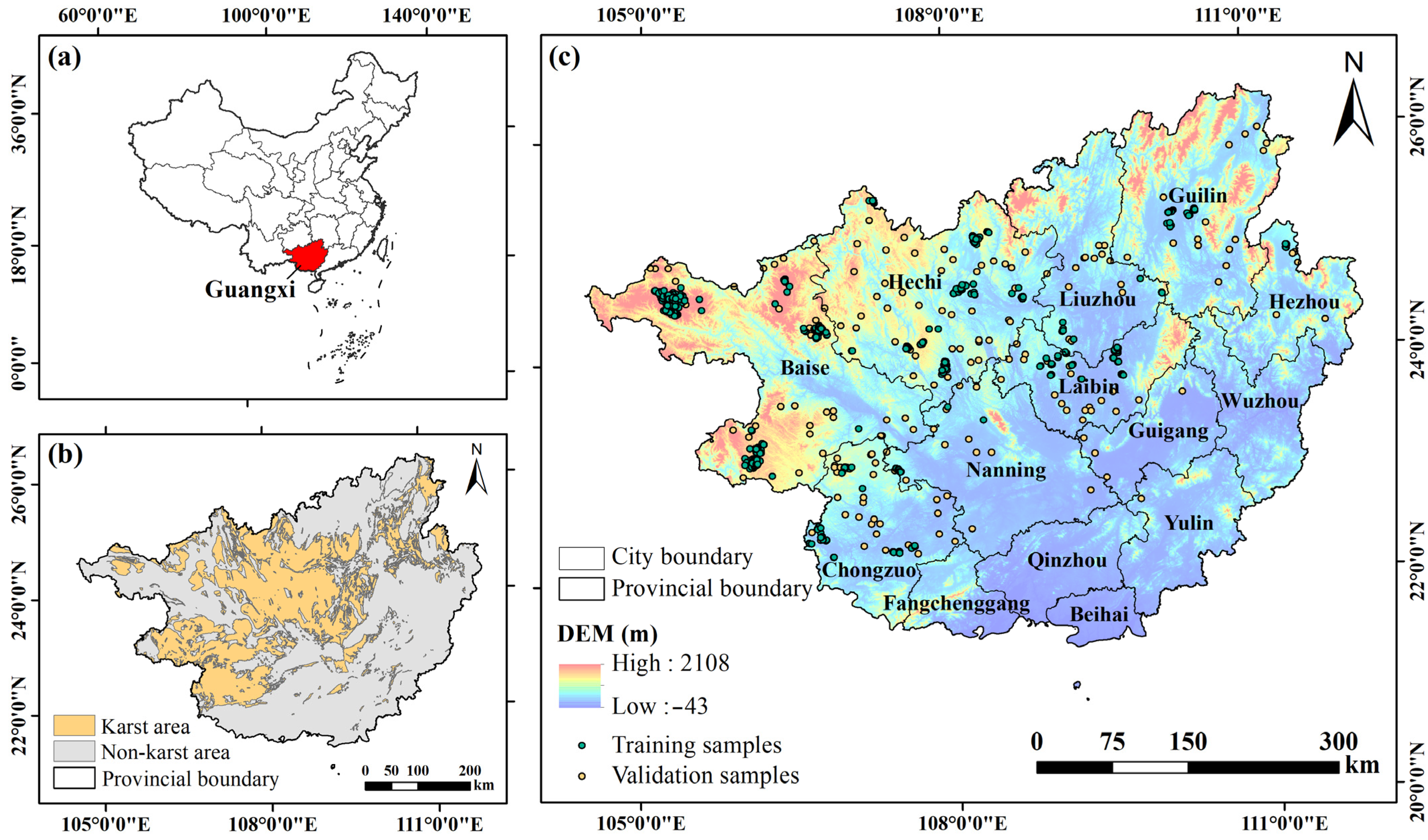
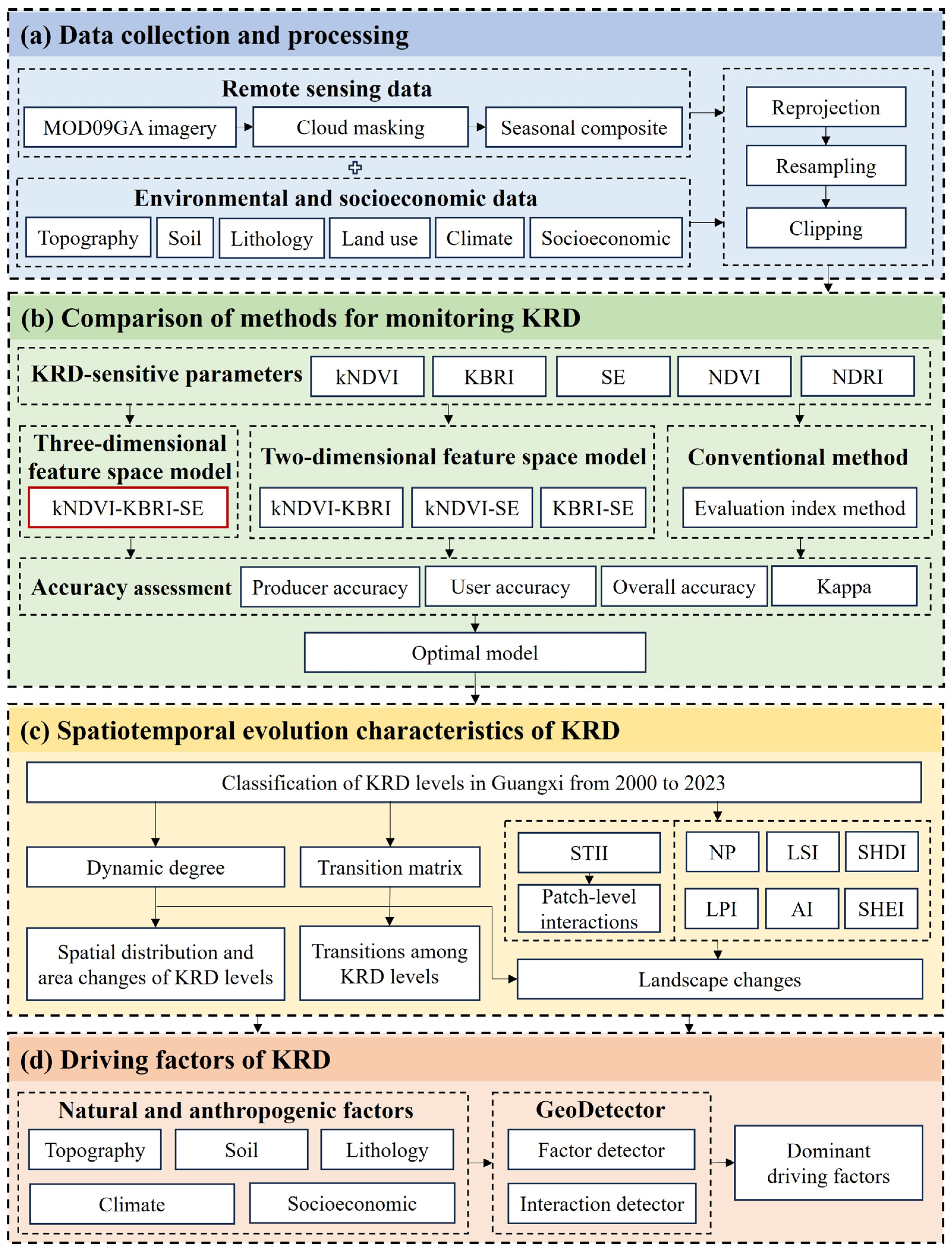

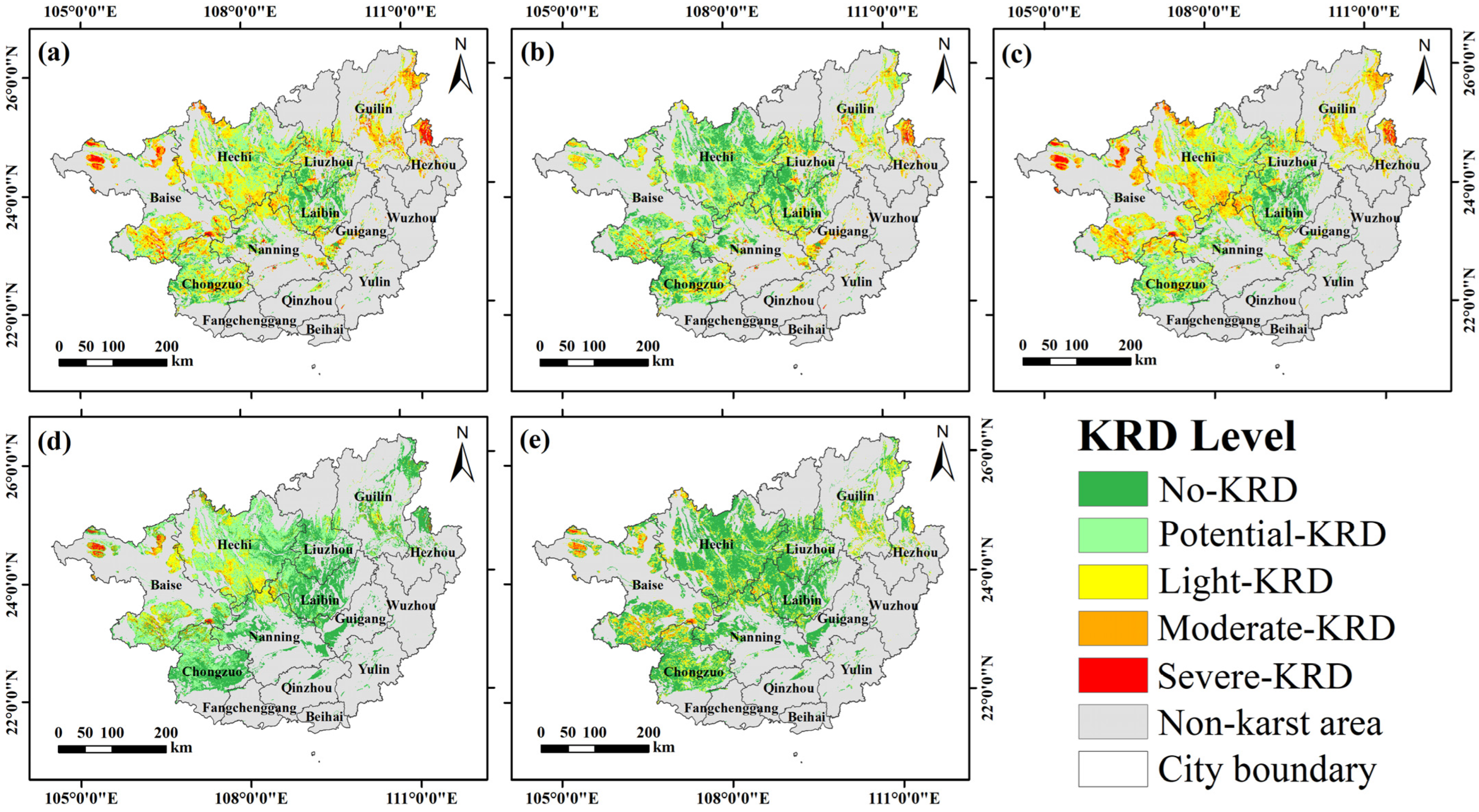
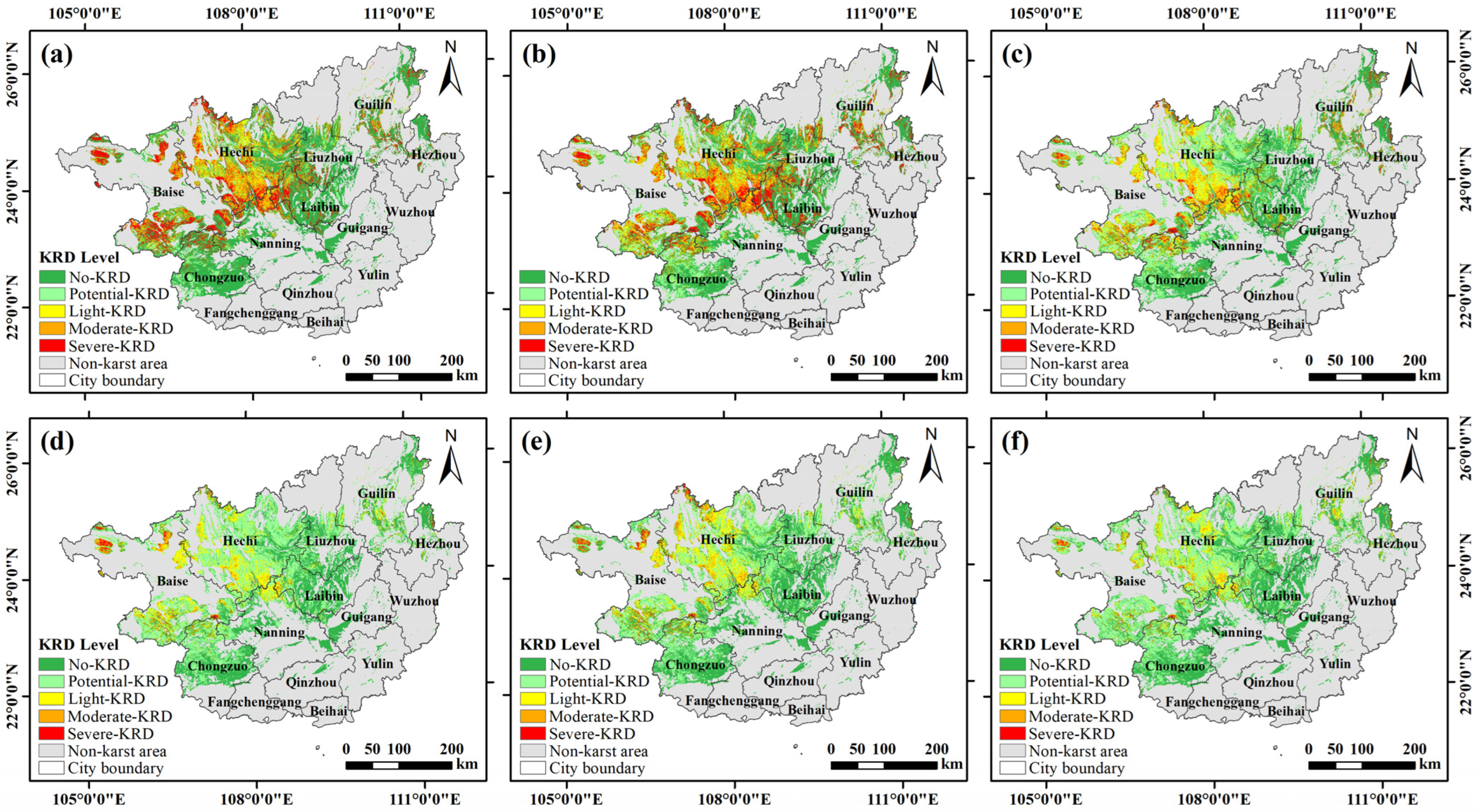
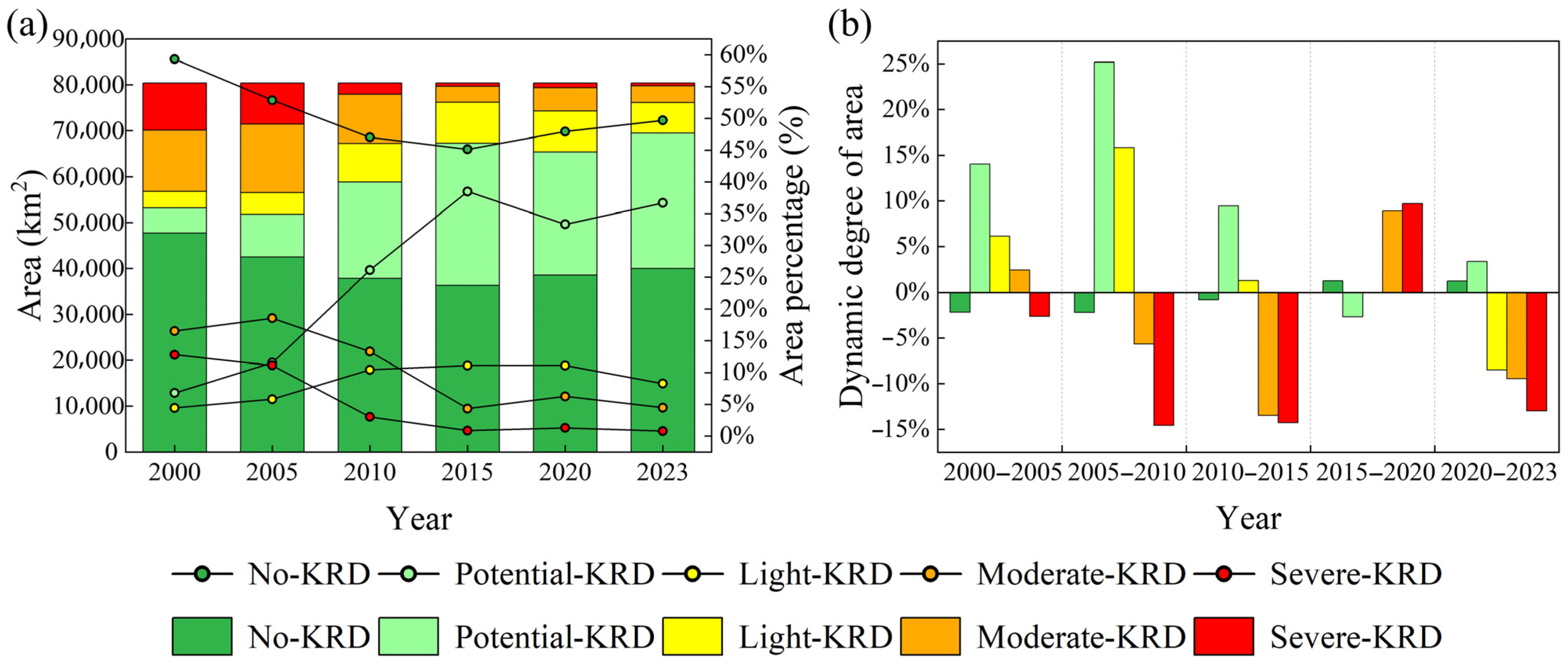
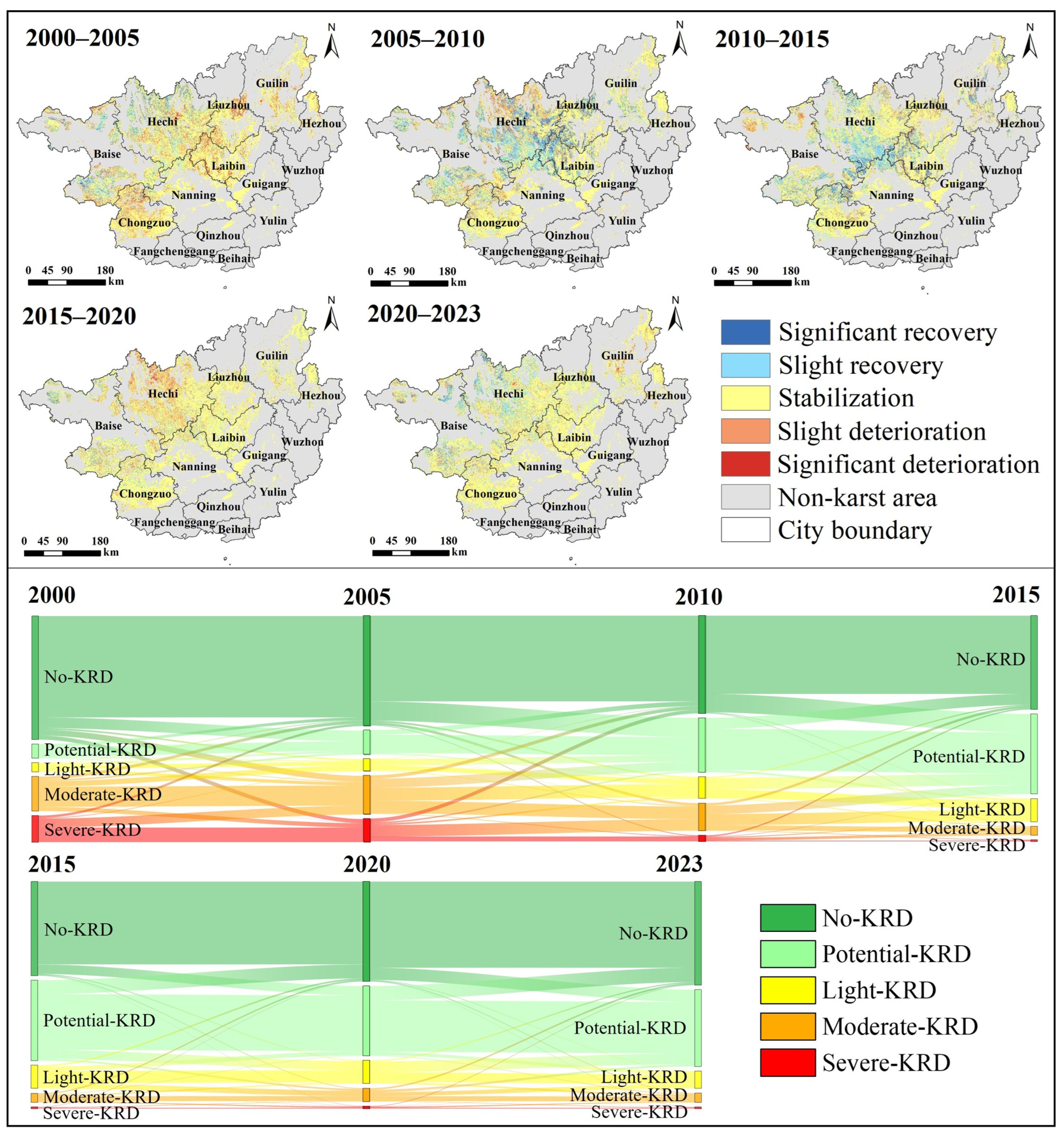
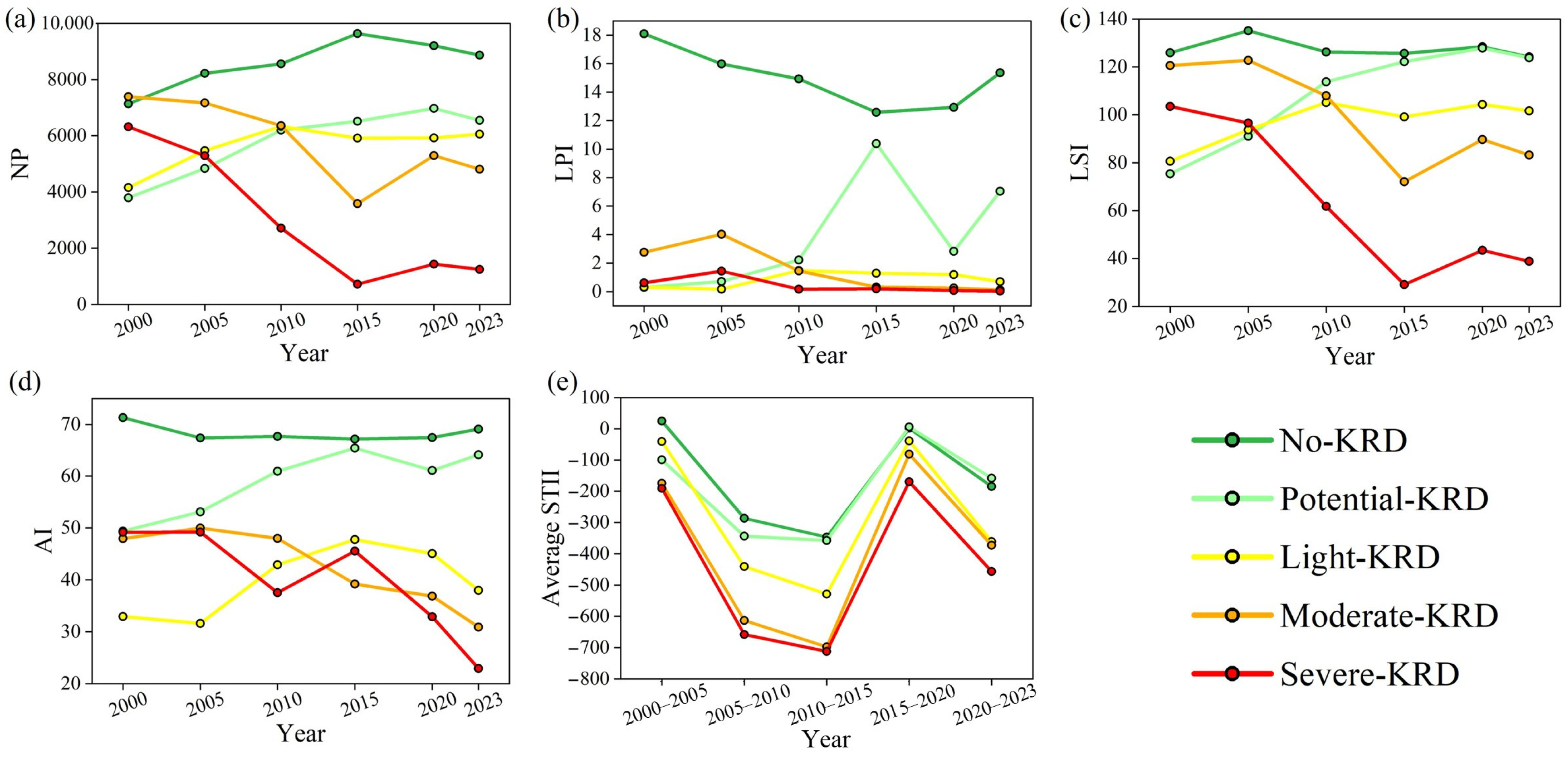

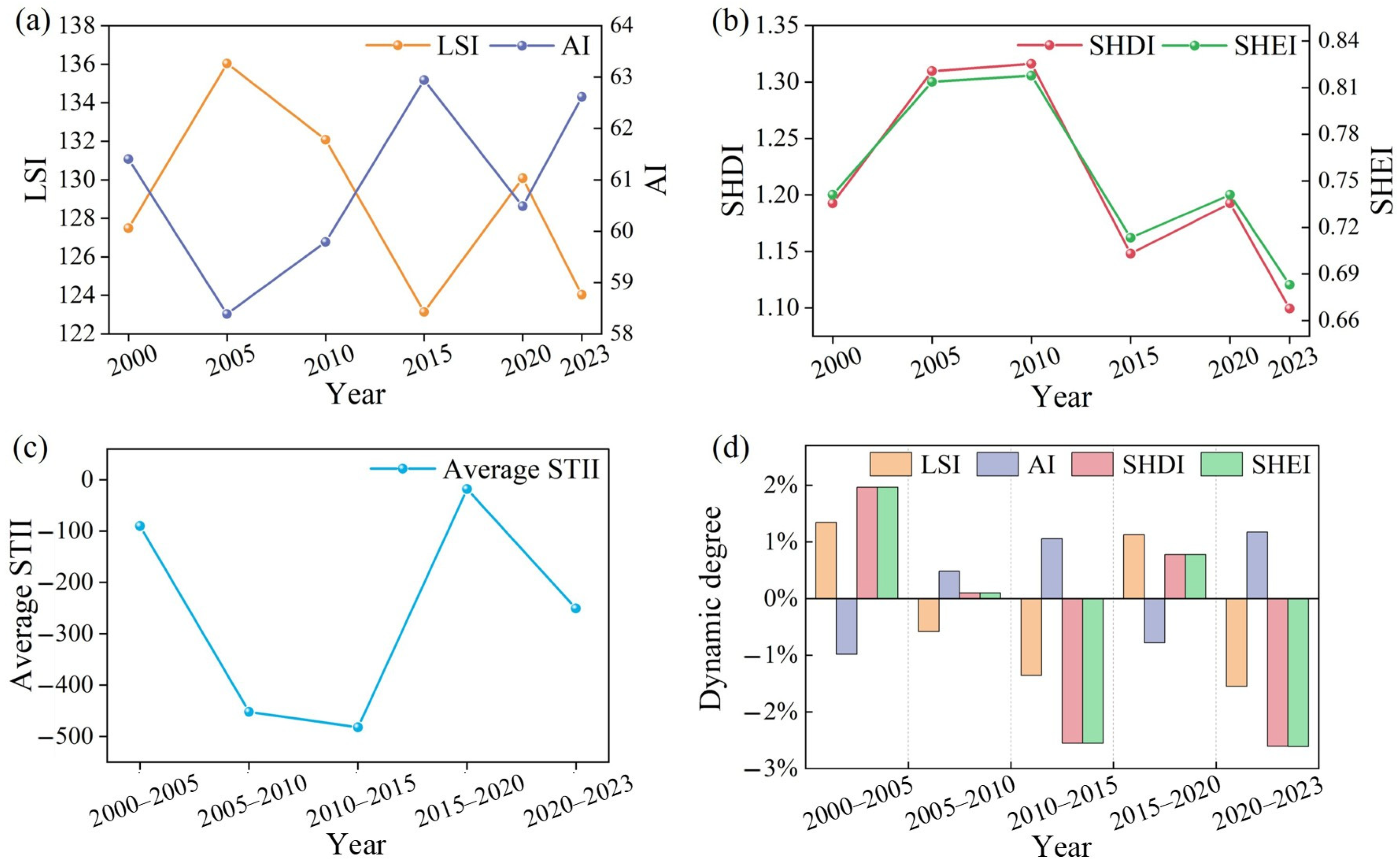
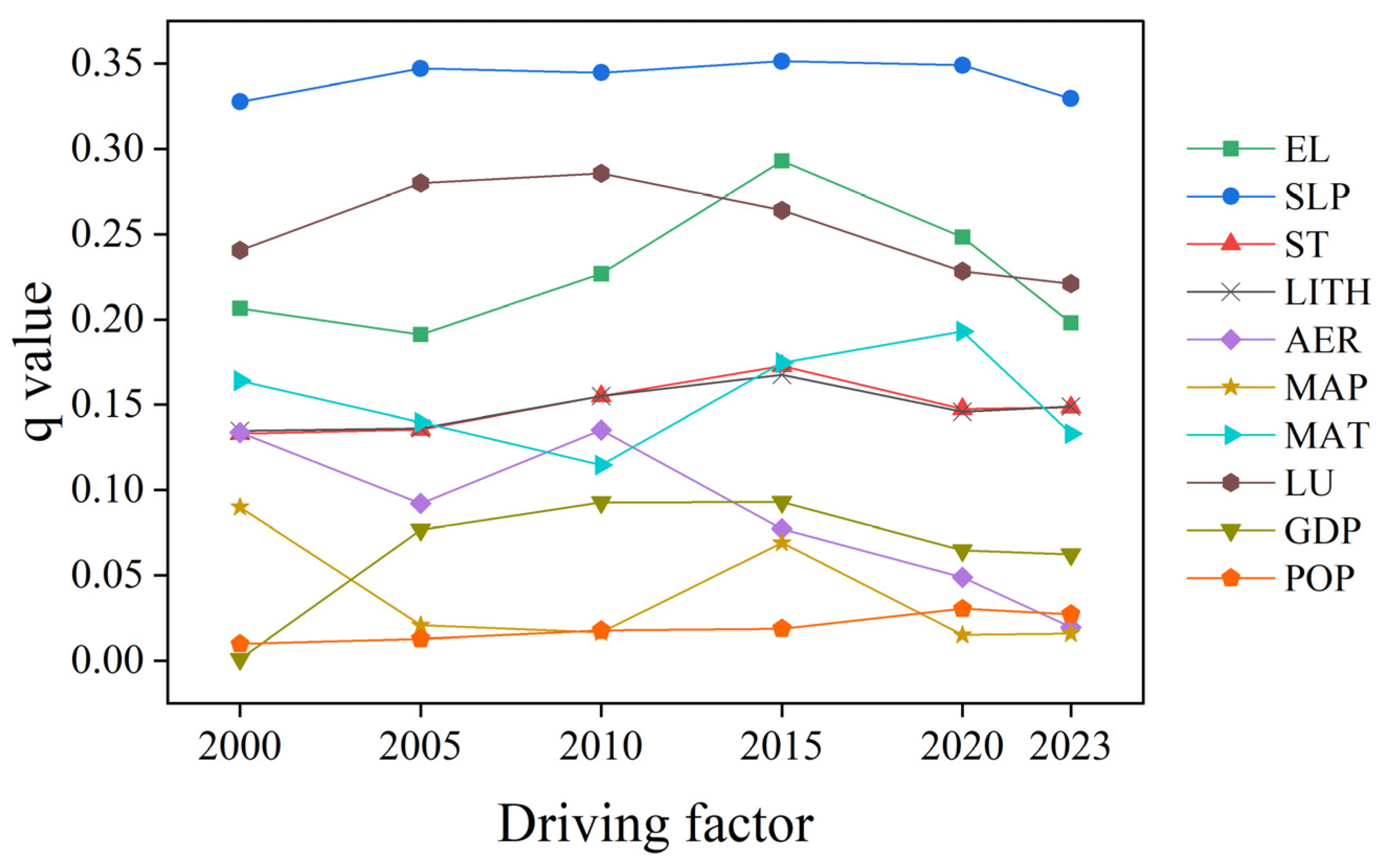
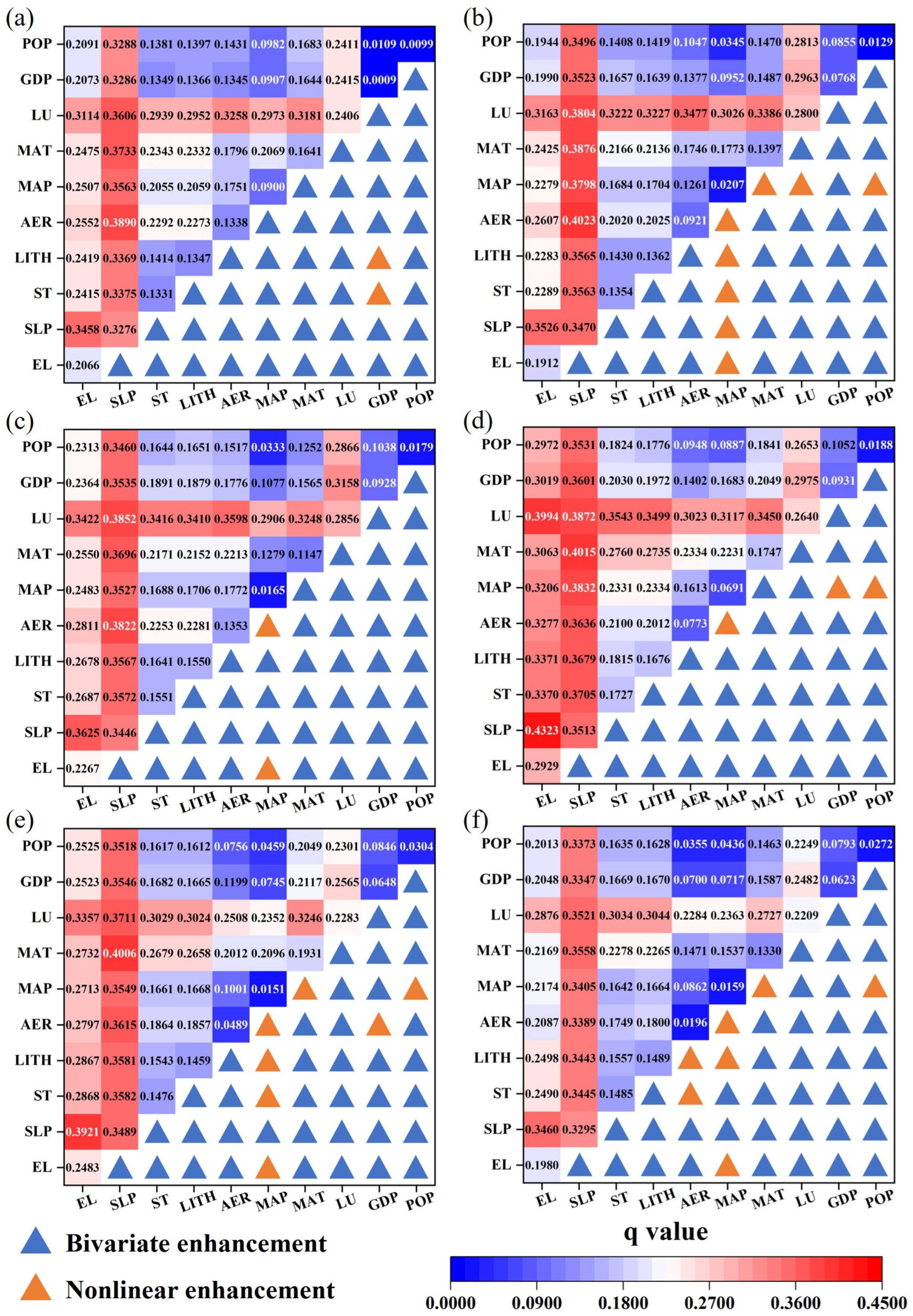
| Data Category | Basic Data | Source | Usage | Resolution | Abbreviation |
|---|---|---|---|---|---|
| Topographic data | Elevation | USGS | Used to calculate the slope length–slope gradient factor (LS) and analyze the driving forces of KRD | 30 m | EL |
| Slope | USGS | 30 m | SLP | ||
| Soil data | Sand, silt, clay, and soil organic carbon contents | ISRIC | Used to calculate the soil erodibility factor (K) | 250 m | – |
| Soil type | ISRIC | Used to analyze the driving forces of KRD | Vector | ST | |
| Lithologic data | Karst distribution | CGS | Used to mask non-karst regions | Vector | – |
| Lithology | ISRIC | Used to analyze the driving forces of KRD | Vector | LITH | |
| Land use data | Land use map | Zenodo | Used to calculate the support practice factor (P) and analyze the driving forces of KRD | 30 m | LU |
| Climate data | Annual erosive rainfall | TPDC | Used to calculate the rainfall erosivity factor (R) and analyze the driving forces of KRD | 0.1° | AER |
| Mean annual precipitation | TPDC | Used to analyze the driving forces of KRD | 1 km | MAP | |
| Mean annual temperature | TPDC | 1 km | MAT | ||
| Socioeconomic data | GDP density | RESDP | Used to analyze the driving forces of KRD | 1 km | GDP |
| Population density | LandScan | 1 km | POP |
| KRD Level | Bedrock Exposure Rate (%) | Vegetation Coverage (%) | Slope (°) |
|---|---|---|---|
| No-KRD | <20 | >70 | <5 |
| Potential-KRD | 20–30 | 60–70 | 5–8 |
| Light-KRD | 30–50 | 50–60 | 8–15 |
| Moderate-KRD | 50–70 | 30–50 | 15–25 |
| Severe-KRD | >70 | <30 | >25 |
| Abbreviation | Description | Level | Unit | Implication |
|---|---|---|---|---|
| NP | Number of Patches | Class | - | The number of patches belonging to a particular patch type within the landscape. |
| LPI | Largest Patch Index | Class | % | Proportion of the largest patch within a particular patch type relative to total landscape area. |
| LSI | Landscape Shape Index | Class/ landscape | - | Shape complexity of patches within the landscape. A higher LSI value indicates more irregular and geometrically complex patch configurations. |
| AI | Aggregation Index | Class/ landscape | - | Spatial aggregation degree of landscape components, where lower values correspond to more spatially dispersed patch distributions. |
| SHDI | Shannon’s Diversity Index | Landscape | - | Reflecting landscape heterogeneity, with heightened sensitivity to uneven distribution patterns among patch types. |
| SHEI | Shannon’s Evenness Index | Landscape | - | The ratio of the SHDI to its theoretical maximum value under a given landscape richness. It reflects the evenness of patch type distribution across the landscape. |
| Criterion | Interaction |
|---|---|
| q(X1 ∩ X2) < Min(q(X1), q(X2)) | Nonlinear weakening |
| Min(q(X1), q(X2)) < q(X1 ∩ X2) < Max(q(X1), q(X2)) | Unique weakening |
| q(X1 ∩ X2) > Max(q(X1), q(X2)) | Bivariate enhancement |
| q(X1 ∩ X2) = q(X1) + q(X2) | Independent |
| q(X1 ∩ X2) > q(X1) + q(X2) | Nonlinear enhancement |
| KRD Level | No-KRD | Potential-KRD | Light-KRD | Moderate-KRD | Severe-KRD | Total |
|---|---|---|---|---|---|---|
| No-KRD | 47 | 2 | 0 | 0 | 0 | 49 |
| Potential-KRD | 2 | 52 | 3 | 0 | 0 | 57 |
| Light-KRD | 0 | 2 | 38 | 1 | 0 | 41 |
| Moderate-KRD | 0 | 0 | 2 | 32 | 1 | 35 |
| Severe-KRD | 0 | 0 | 0 | 2 | 26 | 28 |
| Total | 49 | 56 | 43 | 35 | 27 | 210 |
| Method | No-KRD | Potential-KRD | Light-KRD | Moderate-KRD | Severe-KRD | |||||||
|---|---|---|---|---|---|---|---|---|---|---|---|---|
| PA | UA | PA | UA | PA | UA | PA | UA | PA | UA | OA | Kappa | |
| (%) | (%) | (%) | (%) | (%) | (%) | (%) | (%) | (%) | (%) | (%) | ||
| kNDVI-KBRI | 75.51 | 92.50 | 69.64 | 81.25 | 79.07 | 64.15 | 74.29 | 76.47 | 96.30 | 74.29 | 77.14 | 0.71 |
| kNDVI-SE | 81.63 | 60.61 | 62.50 | 60.34 | 55.81 | 55.81 | 45.71 | 57.14 | 48.15 | 86.67 | 60.95 | 0.50 |
| KBRI-SE | 71.43 | 94.59 | 67.86 | 76.00 | 62.79 | 58.70 | 60.00 | 53.85 | 92.59 | 65.79 | 69.52 | 0.62 |
| kNDVI-KBRI-SE | 95.92 | 95.92 | 92.86 | 91.23 | 88.37 | 92.68 | 91.43 | 91.43 | 96.30 | 92.86 | 92.86 | 0.91 |
| Evaluation index method | 87.76 | 47.78 | 39.29 | 66.67 | 46.51 | 66.67 | 77.14 | 71.05 | 66.67 | 94.74 | 61.90 | 0.52 |
| Year | No-KRD | Potential-KRD | Light-KRD | Moderate-KRD | Severe-KRD | |||||||
|---|---|---|---|---|---|---|---|---|---|---|---|---|
| PA | UA | PA | UA | PA | UA | PA | UA | PA | UA | OA | Kappa | |
| (%) | (%) | (%) | (%) | (%) | (%) | (%) | (%) | (%) | (%) | (%) | ||
| 2010 | 93.62 | 95.65 | 90.74 | 89.09 | 86.05 | 90.24 | 91.89 | 87.18 | 93.10 | 93.10 | 90.95 | 0.89 |
| 2015 | 95.92 | 95.92 | 92.86 | 91.23 | 88.37 | 92.68 | 91.43 | 91.43 | 96.30 | 92.86 | 92.86 | 0.91 |
| 2020 | 92.31 | 93.75 | 86.79 | 92.00 | 88.89 | 86.49 | 94.29 | 86.84 | 90.48 | 90.48 | 90.48 | 0.88 |
| Year | Rank | Main Interaction | q-Value |
|---|---|---|---|
| 2000 | 1 | AER ∩ SLP | 0.3890 |
| 2 | MAT ∩ SLP | 0.3733 | |
| 3 | LU ∩ SLP | 0.3606 | |
| 4 | MAP ∩ SLP | 0.3563 | |
| 5 | EL ∩ SLP | 0.3458 | |
| 2005 | 1 | AER ∩ SLP | 0.4023 |
| 2 | MAT ∩ SLP | 0.3876 | |
| 3 | LU ∩ SLP | 0.3804 | |
| 4 | MAP ∩ SLP | 0.3798 | |
| 5 | LITH ∩ SLP | 0.3565 | |
| 2010 | 1 | LU ∩ SLP | 0.3852 |
| 2 | AER ∩ SLP | 0.3822 | |
| 3 | MAT ∩ SLP | 0.3696 | |
| 4 | EL ∩ SLP | 0.3625 | |
| 5 | LU ∩ AER | 0.3598 | |
| 2015 | 1 | EL ∩ SLP | 0.4323 |
| 2 | MAT ∩ SLP | 0.4015 | |
| 3 | LU ∩ EL | 0.3994 | |
| 4 | LU ∩ SLP | 0.3872 | |
| 5 | MAP ∩ SLP | 0.3832 | |
| 2020 | 1 | MAT ∩ SLP | 0.4006 |
| 2 | EL ∩ SLP | 0.3921 | |
| 3 | LU ∩ SLP | 0.3711 | |
| 4 | AER ∩ SLP | 0.3615 | |
| 5 | ST ∩ SLP | 0.3582 | |
| 2023 | 1 | MAT ∩ SLP | 0.3558 |
| 2 | LU ∩ SLP | 0.3521 | |
| 3 | EL ∩ SLP | 0.3460 | |
| 4 | ST ∩ SLP | 0.3445 | |
| 5 | LITH ∩ SLP | 0.3443 |
Disclaimer/Publisher’s Note: The statements, opinions and data contained in all publications are solely those of the individual author(s) and contributor(s) and not of MDPI and/or the editor(s). MDPI and/or the editor(s) disclaim responsibility for any injury to people or property resulting from any ideas, methods, instructions or products referred to in the content. |
© 2025 by the authors. Licensee MDPI, Basel, Switzerland. This article is an open access article distributed under the terms and conditions of the Creative Commons Attribution (CC BY) license (https://creativecommons.org/licenses/by/4.0/).
Share and Cite
Su, J.; Liu, M.; Yang, Q.; Liu, X.; Wu, Z.; Wen, Y. Spatiotemporal Evolution and Driving Factors of Karst Rocky Desertification in Guangxi, China, Under Climate Change and Human Activities. Remote Sens. 2025, 17, 2294. https://doi.org/10.3390/rs17132294
Su J, Liu M, Yang Q, Liu X, Wu Z, Wen Y. Spatiotemporal Evolution and Driving Factors of Karst Rocky Desertification in Guangxi, China, Under Climate Change and Human Activities. Remote Sensing. 2025; 17(13):2294. https://doi.org/10.3390/rs17132294
Chicago/Turabian StyleSu, Jialei, Meiling Liu, Qin Yang, Xiangnan Liu, Zeyan Wu, and Yanan Wen. 2025. "Spatiotemporal Evolution and Driving Factors of Karst Rocky Desertification in Guangxi, China, Under Climate Change and Human Activities" Remote Sensing 17, no. 13: 2294. https://doi.org/10.3390/rs17132294
APA StyleSu, J., Liu, M., Yang, Q., Liu, X., Wu, Z., & Wen, Y. (2025). Spatiotemporal Evolution and Driving Factors of Karst Rocky Desertification in Guangxi, China, Under Climate Change and Human Activities. Remote Sensing, 17(13), 2294. https://doi.org/10.3390/rs17132294






